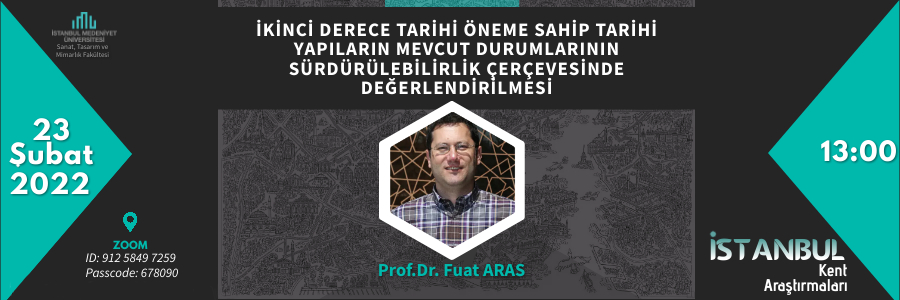The 27th seminar of the “Istanbul Urban Studies” seminar series organized by the Department of Urban and Regional Planning of Istanbul Medeniyet University moderated by Res.Asst. Ayça ÇELİKBİLEK was held online on Wednesday, 23 February 2022. Prof. Dr. Fuat ARAS from the Department of Civil Engineering of our university presented his study named “İkinci Derece Tarihi Öneme Sahip Tarihi Yapıların Mevcut Durumlarının Sürdürülebilirlik Çerçevesinde Değerlendirilmesi” (Evaluation of 2. Degree Historical Buildings Within the Framework of Sustainablity’).
ARAS starting his presentation with the explanations of cultural and natural property, registered property and registration process said that artistic value, technical value, historical importance of are crucial factors which should be considered to classify and register historical buildings. The researcher referring the emergence of sustainability as a concept and its reflections on literature mentioned that conserving historical buildings and their surroundings overlaps perfectly with sustainability perspectives. ARAS talking about the second group of historical structures which are the examples of civil architecture and organic parts of cities explained the results of 200 interviews carried by building owners. The researcher evaluating the structures in terms of conservation- usage conditions, architectural renovations and their finance pointed that only 10% of historical buildings were conserved properly. He also argued why historical buildings damaged by defective implementations (which are 60% of total number of buildings evaluated through case study) can´t be conserved and asked whether conservation is sustainable or how to be done.
ARAS arguing historical conservation through the three components of sustainability emphasized that historical buildings should be conserved by renovation, restoration and modification techniques instead of demolishing and rebuilding to provide environmental sustainability. He further claimed that renovations done with materials like concrete and iron which are not harmonious with historical buildings and hard to produce are environmentally hazardous and not sustainable for waste disposal. It was discussed that historical buildings are mostly located in city centers on lands with highest values but generally property owners can not afford to renovate those buildings and they are not willing to conserve or restore unless they see a chance to extra income. ARAS emphasized the importance of economic empowerment of property owners precisely because it is one of the key factors of conservation. ARAS discussed that adaptable reuse of historical buildings with commercial functions is a way of conservation although economic return can not be the only criteria without social and cultural wealth. While conservation of historical buildings is the result of relations between human an society, it also symbolizes the sense of belonging and being owned. In that sense, ARAS told that historical buildings are not only a part of cultural heritage but also shared values which means that historical conservation is a way to appreciate common culture. He also stressed that historical conservation culture is very crucial because of the future and sustainability of city and urbanism.
As a result of his comprehensive study, ARAS mentioned that conservation of historical buildings needs to be carried out by regarding eigen values, architectural identities, historical and cultural values of structures and applying proper adaptive reuse methods. He further added that if it is aimed to provide a comprehensive sustainability approach for conservation, historical buildings should be conserved as a whole with their surroundings.
In the following q/a session, adaptive reuse implementations on secondary group historical buildings were discussed in terms of suitability of renovations. Also, financial aids endowed historical building owners and their sufficiency was discussed. The need of structure reinforcement of historical buildings for disaster resilient buildings was mentioned because those buildings are vulnerable and full of risks for secondary disasters. Finally, the use of reproductive and imitative components on new structures or architectural renovations were talked over in addition to the conservative restoration process of architectural and cultural heritage. It was discussed whether Turkey is fully-staffed in terms of available restoration experts and other staffs.
Click here to watch the recording of the seminar.


